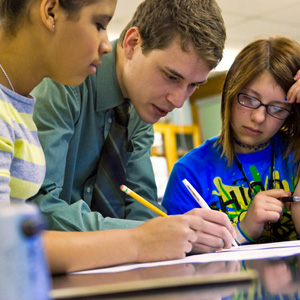
06/19/2013
Hundreds of students from two rural, high-needs Central New York school districts will receive extra instruction from dozens of SUNY Cortland’s future educators, thanks to a more than $250,000 New York State Education Department grant.
The Lafayette and Tully school districts will collaborate with the College year-round on a variety of programs designed to enrich the academic experiences of area primary and secondary school students. Federally funded by the 21st Century Community Learning Centers (CCLC) Program, the three-year, $257,385 grant is aimed at helping students in high-poverty districts meet academic standards.
The award also will give SUNY Cortland students aspiring to teach health, mathematics, physical education or science opportunities to work in a classroom before they become student teachers near the end of their undergraduate careers.
“I think that with the increasing pressure on all schools (based on state Common Core standards), we look at this program as a win-win for both us and the school districts,” said Marley Barduhn ’76, M ’79, SUNY Cortland’s assistant provost for teacher education. “It allows collaboration and partnership so that we all can work together to help students achieve academic success.”
Barduhn co-authored the grant with Doug Wieczorek, SUNY Cortland’s director of field experience and school partnerships, and the superintendents from both school districts: Kraig Pritts C.A.S. ’96, from Tully, and Peter Tigh, from Lafayette.
Only 125 grants were awarded, mostly to urban school districts, out of more than 450 proposals submitted. All proposals were required to serve a high percentage of students from low-income families.
With the Common Core requirements in mind, programs for both the academic year and the summer have been mapped out to boost learning in mathematics, English language arts, science and other content areas. SUNY Cortland’s teacher education program will supply talented student tutors and program leaders throughout the year.
While school is in session, the College’s undergraduates, under the guidance of SUNY Cortland faculty members and district schoolteachers, will provide academic intervention services to Lafayette and Tully students in grades 7 to 12 by offering support to youths during scheduled study halls. And at the Onondaga Nation School in the Lafayette district, they’ll lead lessons related to health and exercise as part of an afterschool program.
“The idea is that we’ll have pre-service education students there so they get some real hands-on experience with students and small groups and so on,” said Pritts.
During the second and third years of the grant, in the summers of 2014 and 2015, students in grades 4 to 8 will spend a week at Bowers Hall on the SUNY Cortland campus, where their focus will shift to science. A $43 million renovation currently taking place in Bowers, transforming it into a state-of-the-art hub for scientific research and learning, will be completed before these students arrive.
“This will allow our students to work alongside experienced teachers and staff members from the schools,” said Barduhn, noting that every future teacher studying at SUNY Cortland must complete a minimum of 100 hours of early field experience before they receive a student teaching placement. “They will also share some early and very excellent supervised experiences with younger students.”
Collaboration between SUNY Cortland’s teacher education program and the rural Central New York school districts surrounding campus is not new. The College and Tully Central Schools have partnered on grants and special projects in the past, including one related to renewable energy in 2011. Educators from Tully also have developed a strong relationship with their counterparts in Queensland, Australia, because of SUNY Cortland.
“SUNY Cortland has helped us internationalize our focus quite a bit,” Pritts said.
Barduhn estimated that between eight and 10 SUNY Cortland students would participate in the proposed summer program and 40 to 50 would contribute during the academic year. The grant’s proposed budget counted professional staff services, project evaluation tools, classroom technology and mileage reimbursement among its expenses.
Every dollar is well spent when the schoolchildren benefit, Pritts said.
“The partnership with SUNY Cortland has been strong and continues to be strong and that’s what made this possible,” he said. “We put together programs that we think are going to be great not only for our kids but also for (SUNY Cortland’s) pre-service teachers.
“We just think it’s a win-win all around.”